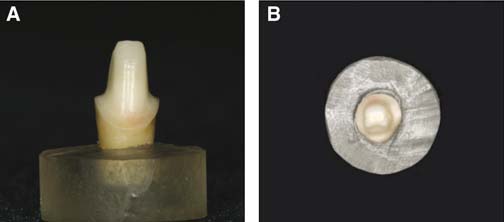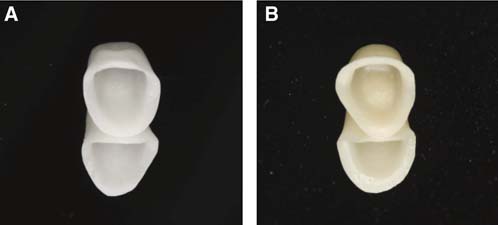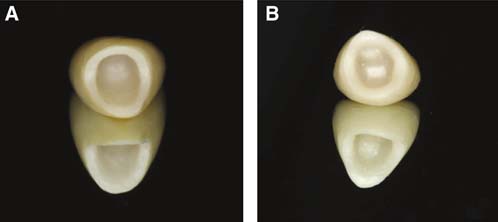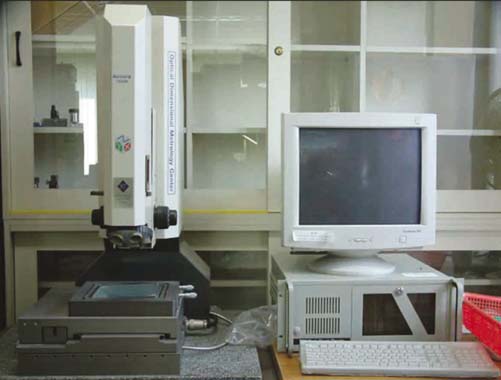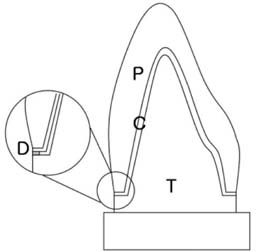J Adv Prosthodont.
2010 Jun;2(2):33-38. 10.4047/jap.2010.2.2.33.
Influence of porcelain veneering on the marginal fit of Digident and Lava CAD/CAM zirconia ceramic crowns
- Affiliations
-
- 1Department of Prosthodontics and Dental Research Institute, School of Dentistry, Seoul National University, Seoul, Korea. jhoyang@snu.ac.kr
- KMID: 1456750
- DOI: http://doi.org/10.4047/jap.2010.2.2.33
Abstract
- PURPOSE
Marginal fit is a very important factor considering the restoration's long-term success. However, adding porcelain to copings can cause distortion and lead to an inadequate fit which exposes more luting material to the oral environment and causes secondary caries. The purpose of this study was to compare the marginal fit of 2 different all-ceramic crown systems before and after porcelain veneering. This study was also intended to verify the marginal fit of crowns originated from green machining of partially sintered blocks of zirconia (Lava CAD/CAM system) and that of crowns obtained through machining of fully sintered blocks of zirconia (Digident CAD/CAM system). MATERIAL AND METHODS: 20 crowns were made per each system and the marginal fit was evaluated through a light microscope with image processing (Accura 2000) at 50 points that were randomly selected. Each crown was measured twice: the first measurement was done after obtaining a 0.5 mm coping and the second measurement was done after porcelain veneering. The means and standard deviations were calculated and statistical inferences among the 2 groups were made using independent t-test and within the same group through paired t-test.
RESULTS
The means and standard deviations of the marginal fit were 61.52 +/- 2.88 micrometer for the Digident CAD/CAM zirconia ceramic crowns before porcelain veneering and 83.15 +/- 3.51 micrometer after porcelain veneering. Lava CAD/CAM zirconia ceramic crowns showed means and standard deviations of 62.22 +/- 1.78 micrometer before porcelain veneering and 82.03 +/- 1.85 micrometer after porcelain veneering. Both groups showed significant differences when analyzing the marginal gaps before and after porcelain veneering within each group. However, no significant differences were found when comparing the marginal gaps of each group before porcelain veneering and after porcelain veneering as well.
CONCLUSION
The 2 all-ceramic crown systems showed marginal gaps that were within a reported clinically acceptable range of marginal discrepancy.
Keyword
Figure
Cited by 1 articles
-
Evaluation of the marginal and internal gap of metal-ceramic crown fabricated with a selective laser sintering technology: two- and three-dimensional replica techniques
Ki-Baek Kim, Jae-Hong Kim, Woong-Chul Kim, Hae-Young Kim, Ji-Hwan Kim
J Adv Prosthodont. 2013;5(2):179-186. doi: 10.4047/jap.2013.5.2.179.
Reference
-
1. Shearer B, Gough MB, Setchell DJ. Influence of marginal configuration and porcelain addition on the fit of In-Ceram crowns. Biomaterials. 1996. 17:1891–1895.2. Balkaya MC, Cinar A, Pamuk S. Influence of firing cycles on the margin distortion of 3 all-ceramic crown systems. J Prosthet Dent. 2005. 93:346–355.3. Davis DR. Comparison of fit of two types of all-ceramic crowns. J Prosthet Dent. 1988. 59:12–16.4. Hung SH, Hung KS, Eick JD, Chappell RP. Marginal fit of porcelain-fused-to-metal and two types of ceramic crown. J Prosthet Dent. 1990. 63:26–31.5. Vahidi F, Egloff ET, Panno FV. Evaluation of marginal adaptation of all-ceramic crowns and metal ceramic crowns. J Prosthet Dent. 1991. 66:426–431.6. Pera P, Gilodi S, Bassi F, Carossa S. In vitro marginal adaptation of alumina porcelain ceramic crowns. J Prosthet Dent. 1994. 72:585–590.7. McLean JW, von Fraunhofer JA. The estimation of cement film thickness by an in vivo technique. Br Dent J. 1971. 131:107–111.8. McLaren EA, Terry DA. CAD/CAM systems, materials, and clinical guidelines for all-ceramic crowns and fixed partial dentures. Compend Contin Educ Dent. 2002. 23:637–641.9. Steger T. Digident CAD/CAM production-growing with the possibilities. Int J Comput Dent. 2004. 7:77–84.10. Piwowarczyk A, Ottl P, Lauer HC, Kuretzky T. A clinical report and overview of scientific studies and clinical procedures conducted on the 3M ESPE Lava All-Ceramic System. J Prosthodont. 2005. 14:39–45.11. Gardner FM. Margins of complete crowns-literature review. J Prosthet Dent. 1982. 48:396–400.12. Beschnidt SM, Strub JR. Evaluation of the marginal accuracy of different all-ceramic crown systems after simulation in the artificial mouth. J Oral Rehabil. 1999. 26:582–593.13. Kern M, Schaller HG, Strub JR. Marginal fit of restorations before and after cementation in vivo. Int J Prosthodont. 1993. 6:585–591.14. Yeo IS, Yang JH, Lee JB. In vitro marginal fit of three all-ceramic crown systems. J Prosthet Dent. 2003. 90:459–464.15. Groten M, Axmann D, Pröbster L, Weber H. Determination of the minimum number of marginal gap measurements required for practical in-vitro testing. J Prosthet Dent. 2000. 83:40–49.16. Gassino G, Barone Monfrin S, Scanu M, Spina G, Preti G. Marginal adaptation of fixed prosthodontics: a new in vitro 360-degree external examination procedure. Int J Prosthodont. 2004. 17:218–223.17. Reich S, Wichmann M, Nkenke E, Proeschel P. Clinical fit of all-ceramic three-unit fixed partial dentures, generated with three different CAD/CAM systems. Eur J Oral Sci. 2005. 113:174–179.18. Hertlein G, Hoscheler S, Frank S, Suttor D. Marginal fit of CAD/CAM manufactured all ceramic prosthesis. J Dent Res. 2001. 80:42–44.19. Gemalmaz D, Alkumru HN. Marginal fit changes during porcelain firing cycles. J Prosthet Dent. 1995. 73:49–54.20. Castellani D, Baccetti T, Clauser C, Bernardini UD. Thermal distortion of different materials in crown construction. J Prosthet Dent. 1994. 72:360–366.21. Lui JL. The effect of firing shrinkage on the marginal fit of porcelain jacket crowns. Br Dent J. 1980. 149:43–45.22. Weaver JD, Johnson GH, Bales DJ. Marginal adaptation of castable ceramic crowns. J Prosthet Dent. 1991. 66:747–753.23. Song TJ. Marginal fit of the auro galvano crown system made using the electroforming technique. 2004. Seoul, Korea: Seoul National University;Master thesis.
- Full Text Links
- Actions
-
Cited
- CITED
-
- Close
- Share
- Similar articles
-
- Comparative fracture strength analysis of Lava and Digident CAD/CAM zirconia ceramic crowns
- Marginal fit of the digident CAD/CAM zirconia ceramic crowns
- The effect of various veneering techniques on the marginal fit of zirconia copings
- A comparison of the fidelity of various zirconia-based all-ceramic crowns fabricated with CAD/CAM systems
- Comparison of marginal fit before and after porcelain build-up of two kinds of CAD/CAM zirconia all-ceramic restorations

